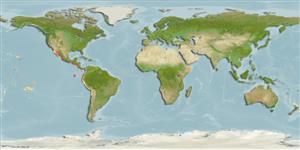>
Callionymiformes (Dragonets) >
Callionymidae (Dragonets)
Etymology: Synchiropus: Greek, syn, symphysis = grown together + Greek, cheir = hand + Greek, pous = foot (Ref. 45335).
More on author: Garman.
Environment: milieu / climate zone / depth range / distribution range
Écologie
marin démersal; profondeur 12 - 232 m (Ref. 58018). Tropical
Eastern Pacific: Costa Rica to Talara, Peru and the Cocos and Galapagos islands; a disjunct population at Gorda Banks, off Cabo San Lucas, Baja California.
Taille / Poids / Âge
Maturity: Lm ? range ? - ? cm
Max length : 16.7 cm TL mâle / non sexé; (Ref. 86316)
Prefers sand and mud habitats, and to a lesser degree, areas of coral rubble. May be encountered by divers in sandy patches among stands of coral or rocky reefs. Feeds on small benthic invertebrates (Ref. 28023). Oviparous (Ref. 56078).
Life cycle and mating behavior
Maturité | Reproduction | Frai | Œufs | Fécondité | Larves
Eschmeyer, W.N. (ed.), 1998. Catalog of fishes. Special Publication, California Academy of Sciences, San Francisco. 3 vols. 2905 p. (Ref. 26282)
Statut dans la liste rouge de l'IUCN (Ref. 130435: Version 2024-2)
Menace pour l'homme
Harmless
Utilisations par l'homme
Outils
Articles particuliers
Télécharger en XML
Sources Internet
Estimates based on models
Preferred temperature (Ref.
123201): 14.7 - 26, mean 17.1 °C (based on 54 cells).
Phylogenetic diversity index (Ref.
82804): PD
50 = 0.5000 [Uniqueness, from 0.5 = low to 2.0 = high].
Bayesian length-weight: a=0.00933 (0.00492 - 0.01771), b=2.84 (2.68 - 3.00), in cm total length, based on LWR estimates for this species & (Sub)family-body (Ref.
93245).
Niveau trophique (Ref.
69278): 3.5 ±0.37 se; based on food items.
Résilience (Ref.
120179): Haut, temps minimum de doublement de population inférieur à 15 mois (Preliminary K or Fecundity.).
Fishing Vulnerability (Ref.
59153): Low vulnerability (10 of 100).
